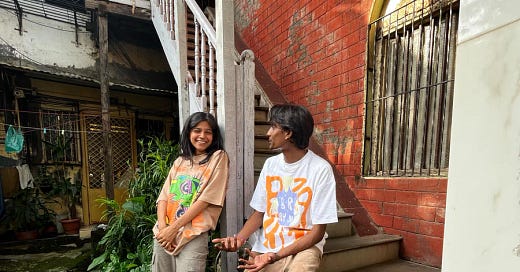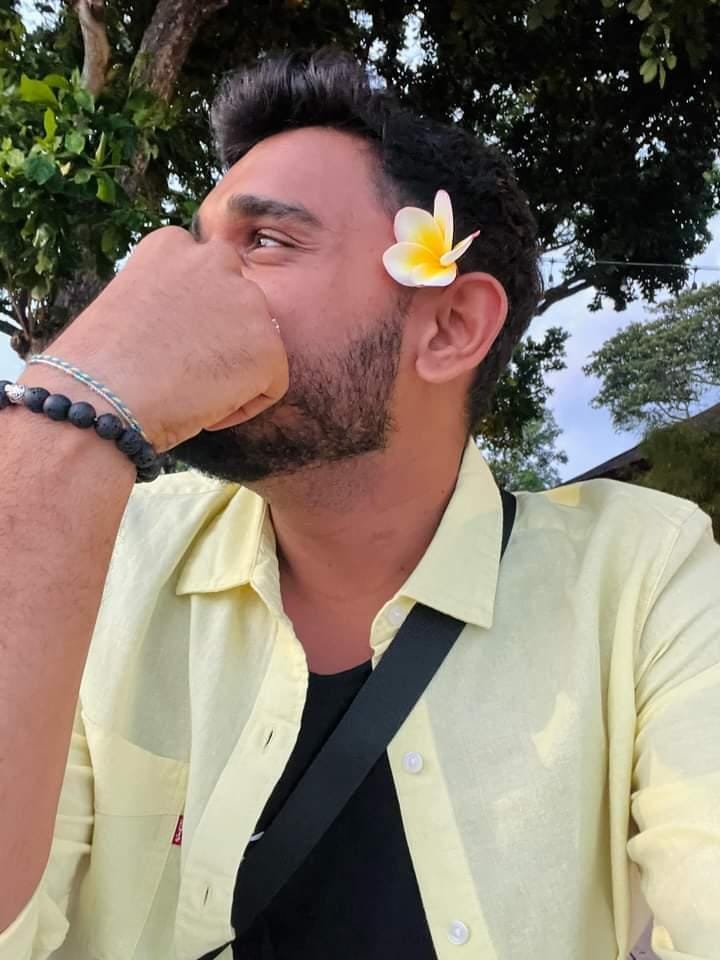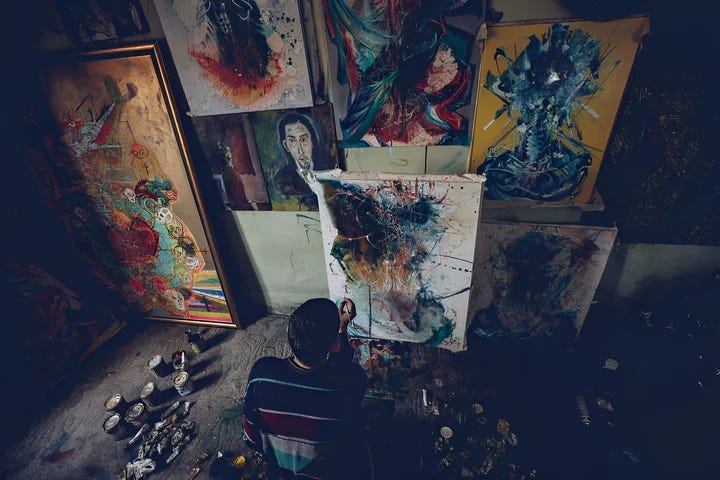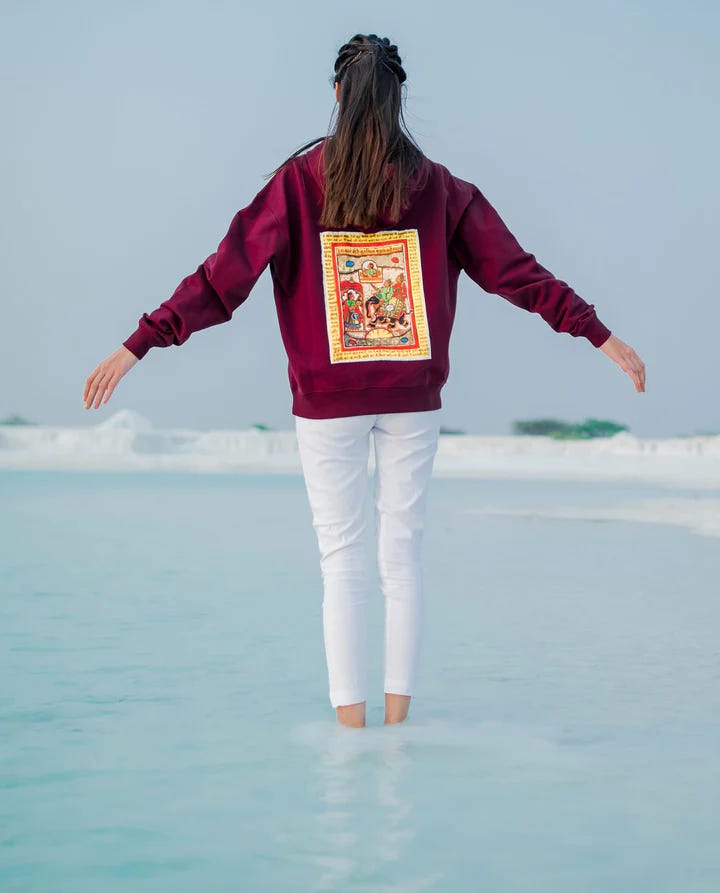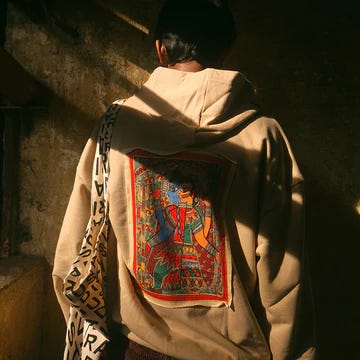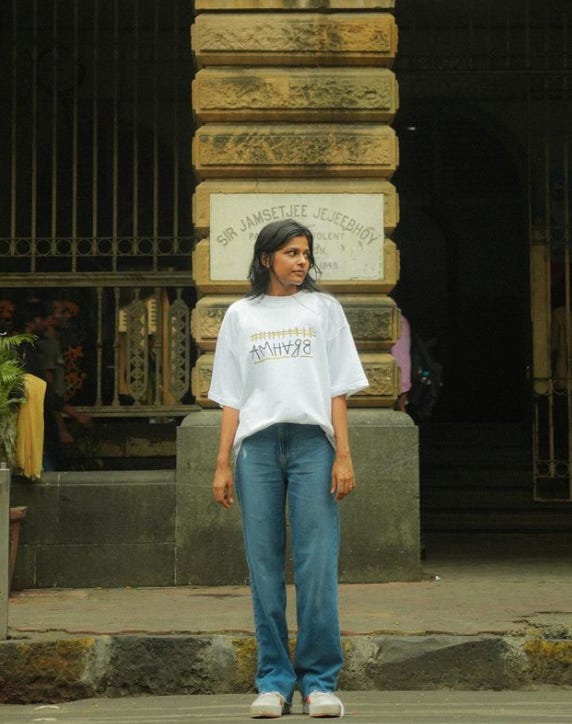This streetwear label brings Indian art & artists into play
Here's how House of Brahma is conceptualising streetwear!
Hello, hello!
New subscribers, welcome! I’m glad you’re here, and I hope you enjoy my recommendations and conversations with Indian brands and their founders. ✨
Last week, I caught up with Harshil Dhabuwala, the founder of House of Brahma — a streetwear brand inspired by Indian arts and culture. Harshil is passionate about art, design, and architecture, and this is evident when you have a conversation with him.
He intends to bring Indian art and sustainability into play with House of Brahma, and here’s what we discussed about the brand. 👇
Please tell me about yourself and what made you start House of Brahma.
I'm from Surat, Gujarat, and I started House of Brahma with my childhood friends around four years back. We wanted to do something in fashion together, but COVID-19 hit five months after we started, and our planning went in vain, so we waited for the right time to enter the market.
While we launched our first lookbook in December 2020, we took a year to plan before that and travelled extensively across India. During those travels, I read books on Indian culture and artefacts, and those inspired me. We are not from a fashion background and had no clue about the industry, including the garments or materials and how designs come alive. However, we were passionate about creating a streetwear brand out of India before streetwear became a trend in our country. So we learned, made mistakes, encountered setbacks, faced Corona, and here we are now!
What did you study and do before launching House of Brahma?
I did Business Management as my Bachelor, but I was fascinated with photography, so I pursued filmmaking at the New York Film Academy. I worked with diverse artists like Yami Gautam and Hrithik Roshan and under many directors. But I took a full plunge into House of Brahma after its launch.
Right. That explains why HoB's Instagram and creatives are so artsy!
HoB is all about art.
While travelling through Rajasthan, Kutch, and some rural parts of Gujarat, our vision is at its peak. Artists from these regions have been practising art for generations, say 500-700 years. Sure, some are moving out to study and pursue other things in cities, but many artists are still creating. Making art is their only livelihood. House of Brahma is bigger than what we do, and I'm not doing it for myself or to make money. It's about bringing the work of these artists into what we do.
So, tell me about your collaborations.
Before discussing our collaborations, I'd like to mention that our brand emphasises education because we are a streetwear brand with designs featuring heritage artists. Not many have done this when we started out, so marketing our apparel wasn't a cakewalk when we started out because it’s not easy to break into something which doesn’t have an existing market.
Talking about our collaborations 👇
For our first look, we worked with an artist who makes Phad paintings, a form of art that has existed for 600-700 years. These paintings are done on huge canvases or cloth, sometimes stretching the length and breadth of a wall. Artists store these by folding them, and this art form is quite popular in Bhilwara, Rajasthan.
We met many artists in Bhilwara, including some Padma Shri awardees, to better understand the art form. They were also quite excited about our fusion of West meets East. So, our first collection featured their painting on hoodies and sweatshirts. Since we got this custom-made for our apparel, if you own it, you're one of the 300 people with the art.
In 2021, we launched a sustainable lookbook featuring Khadi, block prints and natural dyes. The Khadi was produced in Saurashtra, Gujarat, under KVIC. Khadi wasn't popular then, so the response was relatively lukewarm.
That's when we realised we should give people what they want without compromising our values. Our garment manufacturer takes 60-70 days to produce our fabric and achieve the desired colour, so we take time to work with artists, conceptualise our designs, and bring them to life.
We launched distressed caps in our first lookbook, and our manufacturer kept wondering how to pull them off. But we asked them to go to a hardware store and get sandpapers to create that grunge look. We manually worked on each cap. The response was pretty phenomenal.
👉 Watch the video here.
We also launched a Mithila Art collection, which is sold out right now. We work with prestigious artists the younger generations don't recognise, but back then, I assumed pieces like khadi jackets would be readily sold. But they didn't. There was no Shark Tank either; otherwise, I would've gone and promoted the art there.
Each piece takes days to make, as it's handmade and sustainable throughout. Art collaborations and a sustainable approach have been our goals from day one because you're extending proper livelihood to many. Later, we collaborated with diverse modern artists.
Your Instagram bio says, "House for the broken creators." What does that mean?
We mean offering our platform to younger and modern artists whose art we understand. Some of these artists are 19 or 20 years old and collaborate with other fashion labels. We also give our artists complete creative freedom.
Why the name House of Brahma?
Brahma is a creator. We took that concept of creation, and the name also matches our core principle: Creating something that hasn't been created before and won't be created again. Besides, we were four founders when we started the brand, and since Brahma has four heads, the name was a perfect fit.
Having said that, the name or the brand has nothing to do with religion or religious aspects; we believe creation has no religion. Creation is the core of our brand philosophy.
How have you been marketing your label, and what's working for you?
We haven't done enough marketing except a little bit of performance marketing. We get ample traction thanks to word of mouth, but we intend to bring more storytelling to our Instagram content.
Our customer retention is also relatively high. Right from when we started, I spent many hours speaking to customers and gathering their feedback. Even with influencer marketing, we've barter collaborated with influencers who contacted us and haven't pursued any collaborations ourselves. Sure, we could do more in marketing, but we're here.
What are some challenges you face as a small business?
Growing the brand and rapidly establishing its presence are challenges across all small businesses. With limited resources, you can't even build a team overnight, so you need to do smart work and jugaad to get stuff done.
The biggest challenge, however, was when my co-founders returned to their engineering jobs. Things weren't working out as we had hoped; I was building the brand alone, and I've had days when I felt I should pause House of Brahma. Questions like "Am I doing something wrong?" or "Why are things not working despite our passion?" would often come to mind.
You know multiple brands come with money and network effects — when they launch, they become instant hits. We don't come from such a privilege or circle that wouldn't think twice before purchasing something for INR 3,000. All the support we've received so far is from our community, and I've spent time building the community. I remember after our first drop, I called our customers and told them, "Yeh paanch das saal na, aap ye cheezen ghis ke pehen lijiye, kuch nahi hoga. Main yahi baitha hoon." (Wear our products for 5-10 years in whatever way you'd like, and they won't be worn out easily. I'm right here, so you can tell me if the quality changes.) Because we’re bootstrapped and didn’t have much for marketing, we did whatever we could with what we had.
For small businesses, capturing the market and staying in a customer's mind is also challenging because of the number of existing and upcoming homegrown brands.
If we had a fashion background, we probably would've known this sooner — initially, we had a lot of inventory, and some of the biggest brands today don't maintain as much stock as we did back then, which was a mistake and affected our cash flow.
So, several things can go wrong when you start a brand, but there are many differences between starting a brand in 2019 and starting in 2024. Zameen aasmaan ka faraq hain!
But the fact that people recognise us makes the journey worthwhile! We were at Lollapalooza, and I stayed at a hostel where I met diverse people there are at the event. Some of them told me which designs they liked and how they couldn’t order them because they were sold out. That felt good!
What sort of experiences would you like your users to have?
I hope our clothing inspires people. For instance, if you purchase something from us, we want people to deeply relate to the piece and our story. We've also been offering a fun unboxing experience from the start that includes our bookmarks and little things, and it's fully sustainable. Although an unboxing experience is common now, we want our customers to have fun experiences.
Another thing is offering a post-sales experience, where communicating with the customer, seeking feedback, and tweaking things based on their experiences is important to us.
That's great! So, what can we expect in the future?
Offering conceptual pieces and one-of-a-kind wearable art will be our top priority! We'll remain the platform for artists. We’ll also drop more headwear because our caps get so much love.
We're proudly made in India; even if we grow, we'll be homemade.
Our next lookbook will be out in a month or so and will be as experimental and artsy as our earlier ones.
So, that was my conversation with Harshil. Follow House of Brahma on Instagram and check out their website. 👇
I’ll be back with another brand story soon.

